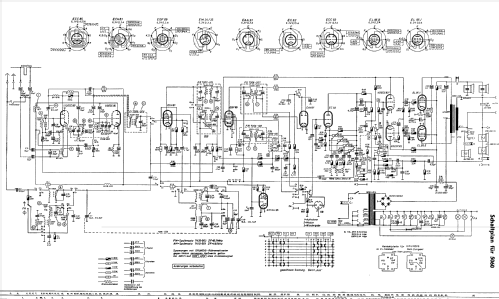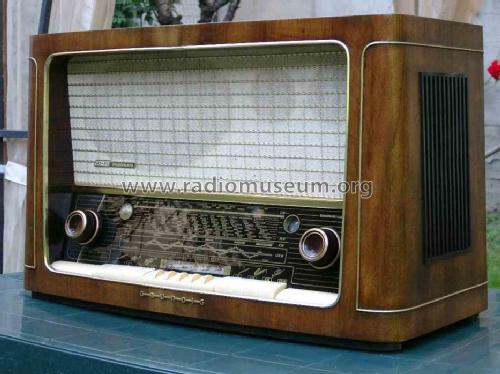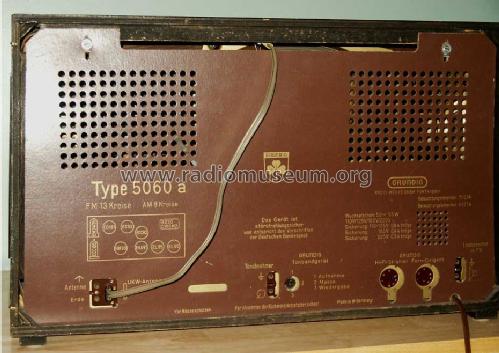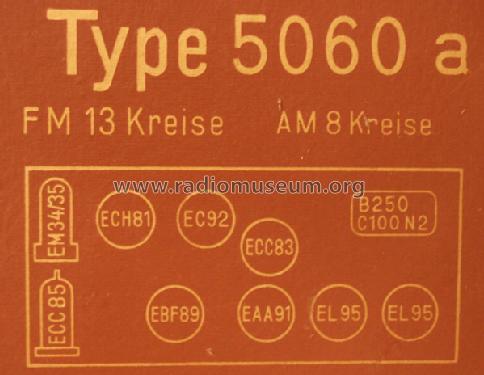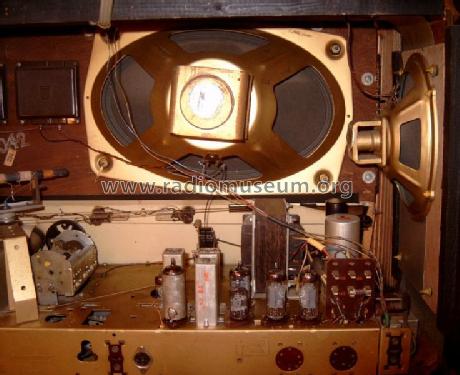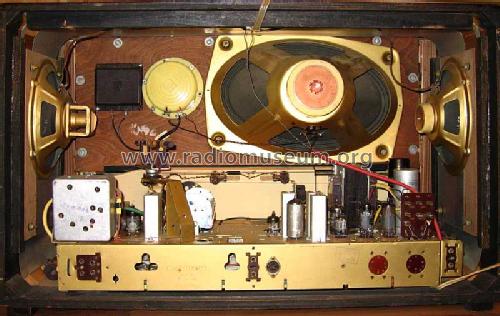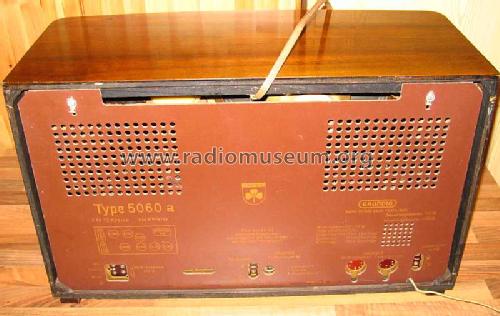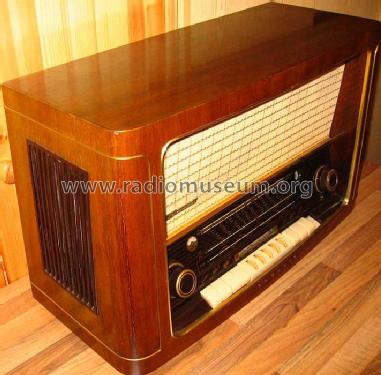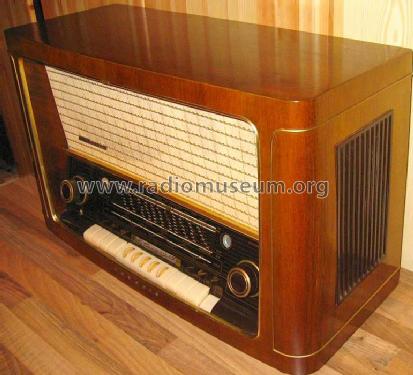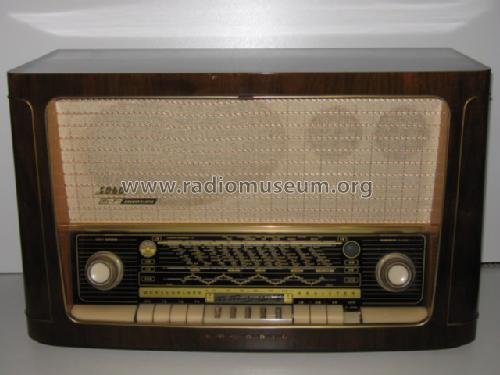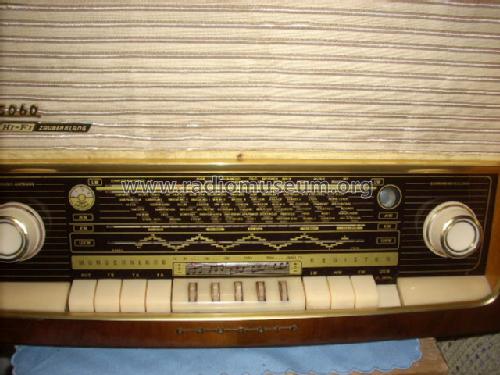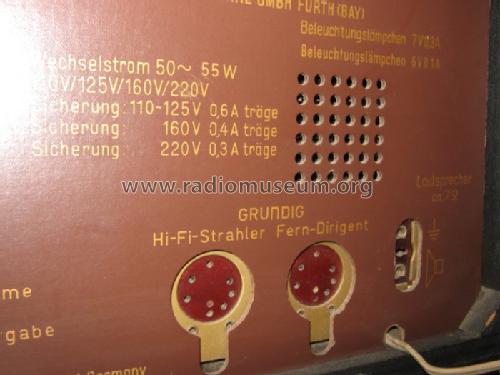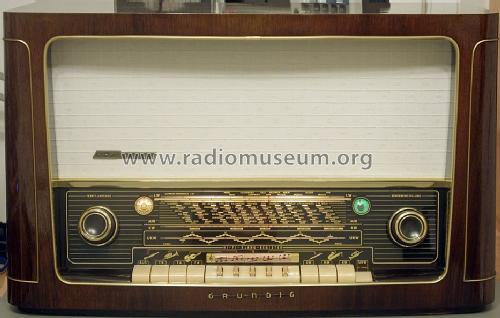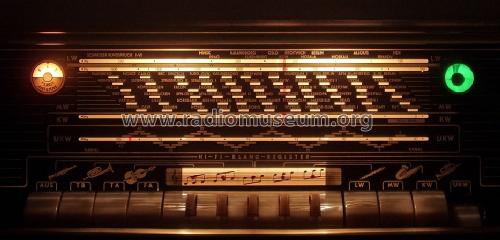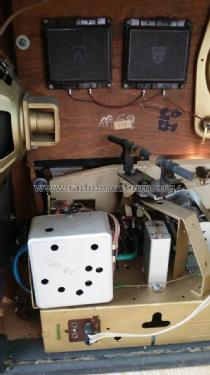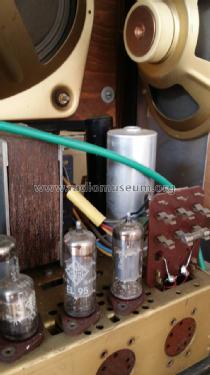- Country
- Germany
- Manufacturer / Brand
- Grundig (Radio-Vertrieb, RVF, Radiowerke); Fürth/Bayern
- Year
- 1957 ?
- Category
- Broadcast Receiver - or past WW2 Tuner
- Radiomuseum.org ID
- 85299
-
- alternative name: Grundig Portugal || Grundig USA / Lextronix
Click on the schematic thumbnail to request the schematic as a free document.
- Number of Tubes
- 9
- Main principle
- Superheterodyne (common)
- Tuned circuits
- 8 AM circuit(s) 13 FM circuit(s)
- Wave bands
- Broadcast, Long Wave, Short Wave plus FM or UHF.
- Details
- Remote Control (with wire or wireless)
- Power type and voltage
- Alternating Current supply (AC) / 110, 125, 160, 220 Volt
- Loudspeaker
- 5 Loudspeakers
- Material
- Wooden case
- from Radiomuseum.org
- Model: 5060a - Grundig Radio-Vertrieb, RVF,
- Shape
- Tablemodel with Push Buttons.
- Dimensions (WHD)
- 650 x 390 x 270 mm / 25.6 x 15.4 x 10.6 inch
- Notes
- Grundig 5060a;
2 Versionen bekannt:
Version 1:
Inlandsausführung mit deutscher Skala und UKW bis 100 MHz,
Ausführung 2:
Mit gleicher deutsch beschrifteten Rückwand jedoch mit englischer Skalenbeschriftung (Tuning, Volume, LW, BC, SW, und US FM bis 108 MHz), Lautsprecherfront ebenfalls mit "5060 Hi-Fi Zauberklang" beschriftet.
Beide Ausführungen mit Wunschklangregister, Anschluß für "HiFi-Strahler" und "Fern-Dirigent".
- Net weight (2.2 lb = 1 kg)
- 15 kg / 33 lb 0.6 oz (33.04 lb)
- Source of data
- -- Collector info (Sammler)
- Author
- Model page created by Gottfried Silberhorn. See "Data change" for further contributors.
- Other Models
-
Here you find 6218 models, 5451 with images and 4215 with schematics for wireless sets etc. In French: TSF for Télégraphie sans fil.
All listed radios etc. from Grundig (Radio-Vertrieb, RVF, Radiowerke); Fürth/Bayern
Collections
The model is part of the collections of the following members.
Forum contributions about this model: Grundig Radio-: 5060a
Threads: 4 | Posts: 7
The flexible cable has a steel jacket and plastic core. This plastic core shrinks substantially both in length and diameter. The shrinkage in length causes a restriction in the range of motion of the highest-frequency tone control, eventually to where the control may not rotate at all. The shrinkage in diameter causes "lost motion" so that the tone control can be moved over a portion of its range without moving the IF transformer slug.
These problems are eliminated by replacing the plastic core of the flexible cable with an insulating material of the correct diameter. After some experimenting I used .039" (1.0 mm) Teflon spaghetti (bus wire tubing). It would be best to insert a short piece of bus wire inside the spaghetti at each end where it is clamped to reduce crushing of the spaghetti. A nice feature of using Teflon is that it is self lubricating, allowing for smooth operation. Ross Hochstrasser, of the Bavarian Radio Works (Massachusetts, USA) stated that he uses filament for a yard string trimmer (weed whacker) for this repair. So there is another idea for core material.
Coarse adjustment of the cable is made by adjusting the position of the IF slug clamp on the cable core. Fine adjustment is made by screwing the end fitting on the IF transformer end of the steel jacket in and out of the mounting bracket. This fitting turns since it is not attached to the jacket, but the locknut must first be loosened. (This fitting should be set in the center of its adjustment range while making the coarse adjustment of clamping the IF slug to the flexible cable core. This adjustment is not critical at all for the operation of the radio as long as the tone control can travel over its full range. As long as the cable core is properly sized so there is no lost motion, the length of IF transformer slug travel is only slightly longer than the cable core travel, and this excess travel should be centered so that the slug is not at the end of its travel at ether end of rotation of the tone control.
I have been informed by a gentleman who previously worked for Grundig that AM IF alignment should be done with the bandwidth control set at the "narrow" end (least amount of treble sound). This detail is not addressed in the alignment instructions.
I have attached a photo of the flexible cable installed in my 5060a after the repair was complete, and also photos of the clamps that attach the cable core to the tone control and the IF transformer slug.
Paul Moyer
Attachments
- Complete flexible cable (65 KB)
- Flex Cable - Tone Control End (47 KB)
- Flex Cable - IF Transformer End (44 KB)
Paul Moyer, 25.Feb.06
Ich suche informationen für dem Grundig 5060, 4090 und ähnlicher modeln mit wunschklang und
variabel ZF bandbreite.
Masse oder anderen abgleich informationen für mechanische bandbreite kabel justage.
OK- I apologize for my very bad grammer.
My German skills are sehr schwere nach 40 yahren keine gespracht.
Ich habt eine schleise messender und oszillograph.
I try this auf Englishe.
Greetings Respected Members!
I seek kindly any information regarding Grundig models equipped with the "Wunschklang" register and variable bandwidth control cable adjustment or setting for models 5060, 4090 and similar models of Grundig.
Necessary for me to further make a new adjustment to this "Bowden Cable" linkung caused by inproper repairs by another in the past.
I have available, and can operate a sweep generator and oscilloscope if necessary.
I understand the concept of this mechanical coupling/ decoupling of the ZF, for hochfrequenz, but I am unsure of what specifications to proper/ exact adjustment.
Thank you!
Dennis Daly (USA)
Dennis Daly, 19.Feb.06
Es würde mich sehr freuen, wenn jemand techn. Unterlagen für dieses Modell hochladen könnte.
Unser Neumitglied, Paul Moyer, USA, sucht dringend eine Abgleichanleitung. Er hat sich das Schema beim 6050 natürlich angesehen, doch fehlt ihm die Abgleichanweisung - noch lieber natürlich in Englisch. Ich kann mir vorstellen, dass es die auch in Englisch gibt, da das Modell 5060a (vorne nur 5060 gegeben) wohl aussschliesslich ein Exportgerät ist. Aber: Deutsch ist besser als nichts.
Ich stehe in Korrespondenz mit ihm und er scheint ein aktives Mitglied werden zu wollen.
Dass er ein ganz interessierter Sammler ist, hat er durch die Aufzählung seiner Literatur beim Antritt bewiesen - und gleichzeitig eine Mitarbeit angekündigt.
Er hat die Suche richtig initialisiert und 14 Tage später auch gepostet - aber in Englisch. Ich kann mir vorstellen, dass viele Mitglieder Englisch (und weitere Fremdsprachen) im Forum ausgeblendet haben und seine Suche nicht sehen. Freuen würde mich eine Antwort hier, wenn jemand die technischen Unterlagen hochgeladen hat. Dann weiss ich, dass ich mich nicht mehr einsetzen muss für dieses Mitglied/Modell. Danke.
Ernst Erb, 02.Dec.05
This radio has a feature that is new to me. The high-frequency tone control connects to one of the IF transformers through a flexible cable. Does this adjust the IF bandwidth? I have no idea how to perform an alignment with this feature.
Paul Moyer, 01.Dec.05
